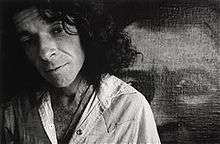Tony Fomison
| Tony Fomison | |
|---|---|
 Fomison, c. 1978 | |
| Born |
12 July 1939 Christchurch |
| Died |
7 February 1990 (aged 50) Waitangi |
| Nationality |
|
Tony Fomison (12 July 1939 – 7 February 1990) was a notable artist in New Zealand. He was an important post-war visual artist in the country and [1] influenced New Zealand art by incorporating elements of narrative and myth into contemporary art.
Fomison was born in Christchurch. He studied sculpture at Canterbury Art School, where he was taught by Rudi Gopas, and during these early years he continued an interest in archaeology which had begun in high school. He also compiled photographic essays during this period. Fomison began painting in earnest in 1960-61. In 1964, he travelled to England and Spain and lived in the former for three years before returning to Christchurch in 1967.[2] During his time in England, he was hospitalised at Banstead Hospital after succumbing to drug addiction.
Fomison moved to Auckland, the largest Polynesian city in the world, in 1973. From that time, his work was influenced by Polynesian culture, including attempts to help revive the skill of traditional Tā moko tattooing. At around this time he met fellow artist Colin McCahon, with whom he struck up a long close friendship.
Fomison was tattooed by Samoan master tattooist Sua Sulu'ape Paulo II with a pe'a, the traditional male tattoo of Samoa.[3] Only a few Europeans have received the traditional Samoan tattoo.
In 1985 Fomison was the inaugural recipient of the Rita Angus Residency. Media reports from the time state that he intended to spend his time in Wellington on the residency developing his contacts with the local Samoan community.[4]
Fomison died at Waitangi during the commemorations of the 150th anniversary of the signing of New Zealand's founding document, the Treaty of Waitangi.
References
- ↑ Brownson, Ron. "Likeness and Character" (PDF). Auckland Art Gallery, Toi o Tamaki.
- ↑ Ross, James. "A Singular Vision: The Paintings of Tony Fomison". Art New Zealand.
- ↑ Wendt, Albert. "Tatauing the Post-Colonial Body". NZEPC. Originally published in Span 42-43 (April–October 1996): 15-29.
- ↑ Wedde, Ian (2005). Making Ends Meet: essays and talks, 1992-2004. Wellington: Victoria University Press. p. 57. ISBN 0864735030.
External links
- Tony Fomison in the collection of the Museum of New Zealand Te Papa Tongarewa